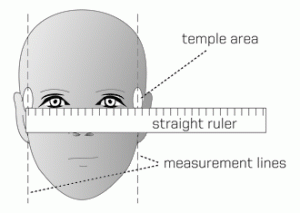Randolph Engineering

Based in Boston, Massachusetts, Randolph Engineering has been creating and manufacturing quality sunglasses since 1972. Randolph Engineering has a worldwide reputation for premium, high technology construction, with an emphasis on quality of materials, comfort and durability
Randolph Engineering sunglasses are used by U.S. armed forces pilots (where Randolph sunglasses are standard issue), the air forces of Australia, Belgium, Israel, Jordan, Pakistan, and South Africa, and the Italian and Pakistani armies. Championship shooters in sporting clays and other competitive shooting sports wear and endorse Randolph Engineering sunglasses. More recently, Randolph Engineering has produced many new European-influenced styles, which reflect today's most fashionable looks, while keeping the same overall commitment to quality.
Frame Sizing Guidelines
|
Looking into your mirror, hold a ruler so it is lined up with each temple. Measure in inches the distance between your left and right temples. |
 |
Suggested Frame Size Face Size (temple to temple) 49mm 115mm or 4.5” |
ABOUT THE FRAMES
Randolph start with absolutely top-grade materials. Then craftsmen cut, solder, plate and polish through 5 weeks and 203 steps, mostly by hand, and all to produce just one pair of sunglasses. And what a pair it is! The frames are also engineered to resist damage. With high-tech metal alloy base construction for strength, 23 karat gold plate (nearly pure) on gold finishes, and solder joints that are guaranteed for the life of the product, you will find no finer frames than Randolph!
Detailed Specifications:
U.S. Made: The pride of American craftsmen.
RX Quality: Suitable for conversion to prescription lenses.
High-Tech Alloy Base Material : Provides strength and solder joint integrity.
Solder Joints: Randolph Engineering feels so strongly about its quality that they will repair or replace any broken solder joint for the life of the product (assuming normal use and handling).
23 Karat Gold Plate: (Nearly pure) on gold finishes. All gold finishes are protected by durable, anti-corrosion clear coat. Salt-spray tested for over 300 hours.
Hand Polishing: Provides lasting lustrous finishes.
Self-Adjusting Nose Pads: Provide balanced fit and comfort.
Smooth Hinges: No sharp corners to snag clothing.
Monoblock Hinges: Allow independent lens or temple removal and replacement.
Stay-Snug or Patented Self-Locking Screws: Bottom-flared or self-locking to prevent backing out.
ABOUT THE LENSES
Randolph use only the highest quality glass or polycarbonate available for their lenses, which are designed for maximum UV absorption and glare reduction. Not only that, but every lens is chem-tempered to resist breakage. In fact, they test each lens by dropping a steel ball on it from 50 inches.
Detailed Specifications:
Maximum UV Absorption (ANSI Z-803 standards}: Designed to help check harsh direct or indirect glare.
Premium U.S. Ophthalmic Crown .
Glass: Ground and polished to precise distortion-free standards.
Optimum Visible Transmittance: Lens densities (darkness) allow only 10-18% of pass-through visible light; the ideal comfort level for most wearers.
Impact Resistant: Every lens is chem-tempered to resist breakage, then drop-ball tested to meet FDA and ANSI standards.
WHY GLASS ?
Glass is one of the oldest and most flexible materials known to man.
Glass resists high temperature changes.
Glass is the most scratch-resistant lens material available.
Glass can be permanently colored. Once colored, it never changes.
Glass simply offers the widest range of lens products.
Q. How do I know what size to buy?
A. While everyone’s style preference varies regarding size, well fitting eyewear is going to be the most comfortable on your face. To find your ideal comfort size, use a ruler and mirror to measure your face from temple to temple, and use the following chart as a guide only:
Find your current frame size if you already own a pair of Randolph Engineering sunglasses
You could also use the size from a current frame you own. Look on the inside of each
temple to find the size of the frame (see illustration below). The eye size is usually
first, then the bridge size, then temple size.

Note: If the eye size is not on the temple, look under the bridge.

A case and a microfiber cleaning cloth is included in your purchase.
We do not recommend the use of polarized lenses for flying. In many cases these will render radio displays, glass cockpits and iPADs unreadable